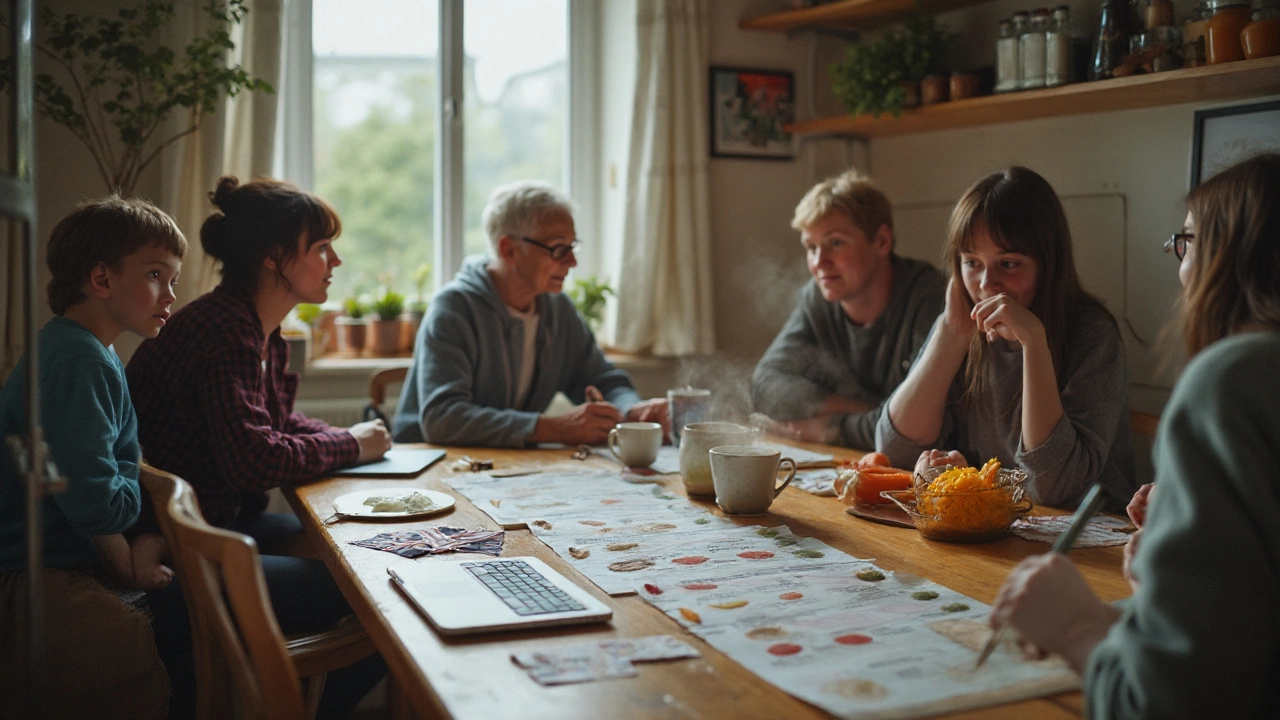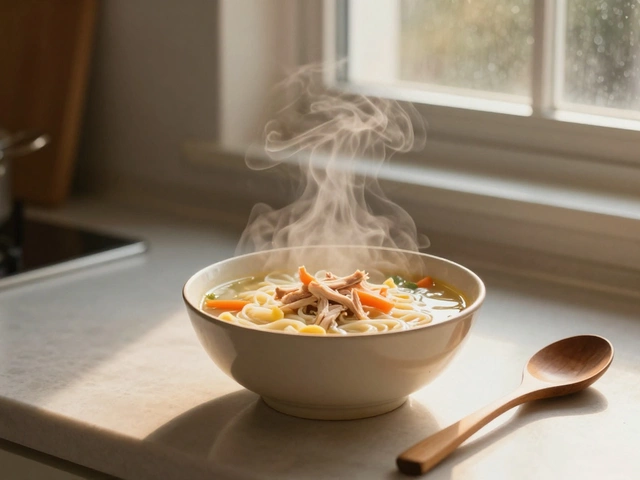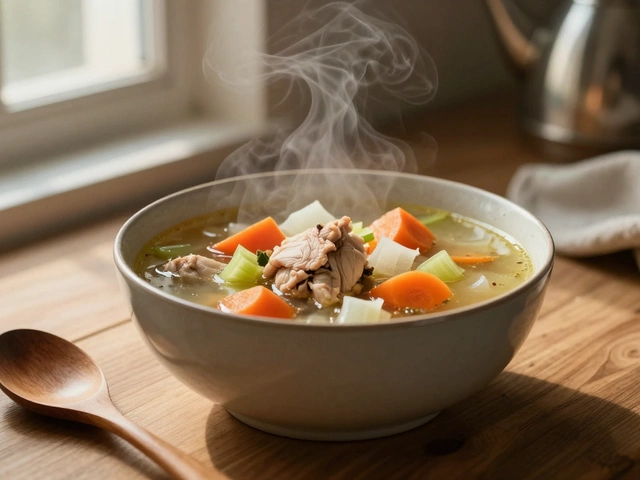Feeding eight people on a tight budget isn’t magic. It’s a simple mix of planning, buying right, and cooking in smart batches. I live in Auckland where food prices still sting, but I can get a filling dinner for 8 on $35-$48 if I stick to a plan: one cheap carb, one hearty protein, one big veg, and a sauce that ties it together. Below you’ll get three crowd-tested menus, a shopping plan with New Zealand prices, and a stress-free timeline so you can actually enjoy the meal too.
- TL;DR
- Target $4-$6 per person by leaning on rice/pasta/potatoes + beans/lentils/cheap chicken + cabbage/carrot/onion + a bold sauce.
- Spend about 60% of the budget on staples, 30% on protein, 10% on flavour (spices, sauces).
- Shop specials at Pak’nSave/Countdown, use Asian grocers for rice/spices, and buy produce by the head (cabbage) not the bag.
- Cook one-pot mains and oven trays. Keep washing low, flavour high.
- Use my three menus with NZD costed lists and a 60-75 minute cooking plan you can follow.
Plan and price: your $4-$6 per person game plan
I’m going to give you a simple formula I use when I’ve got a crowd coming over: one dense carb + one protein + one veg + one sauce. Think rice + chicken + cabbage + yogurt-mayo. Or pasta + lentils + carrots + tomato. It’s not fancy. It just works.
Prices below reflect Auckland specials and everyday pricing I’ve seen in 2025. According to the Stats NZ Food Price Index, prices eased through 2024 after record highs in 2023, but staples are still volatile by store and week. So treat the numbers as ranges, not promises.
Here’s your quick portion math for 8 adults (or 6 adults + 4 kids with seconds):
- Rice: 75-90 g dry per person → 600-720 g total (about 3 cups dry). Ratio: 1 cup rice to 1.6-1.8 cups water for long-grain/basmati on the stovetop.
- Pasta: 90-110 g dry per person → 750-900 g total (about 3/4-1 bag of 1 kg).
- Potatoes: 250-300 g per person → 2-2.5 kg total.
- Beans/lentils (dried): 60-80 g dry per person → 500-650 g total. If using canned, 1 can = ~240 g drained; you’ll want 4-6 cans.
- Chicken (bone-in): 180-220 g raw per person → 1.4-1.8 kg total (drumsticks or thighs).
- Vegetables: at least 1.2-1.5 kg total (cabbage, carrots, onions) for sides and bulk in the main.
Budget split that keeps me honest:
- 60% staples (rice/pasta/potatoes, canned tomatoes, onions, carrots)
- 30% protein (drumsticks/thighs, beans/lentils, eggs)
- 10% flavour (spices, yogurt, soy sauce, cheese topper if on special)
Simple decision tree:
- Meat on special under ~$7/kg (drumsticks, bone-in thighs)? Do a one-pot chicken and rice or tray-bake + carb.
- No meat deal? Build around lentils/beans. Spend a couple of dollars on a punchy sauce (soy, chili, garlic, lemon) and you won’t miss the meat.
- Feeding mixed eaters? Keep the protein separate. Do a big pot of rice/pasta, a veg tray, and two sauces: tomato-lentil and chicken pan juices.
Three menus that beat takeaways for eight people:
- Menu A - One-Pot Chicken Pilaf + Cabbage Slaw + Garlicky Yogurt
- Menu B - Lentil Bolognese with Spaghetti + Buttered Carrots + Toasted Bread
- Menu C - Smoky Bean & Kumara Chili + Rice + Quick Pickled Onions
Why these? They scale cleanly, use cheap staples, and they’re forgiving with timing and heat. They’re also made for leftovers, which saves lunches the next day.
Quick NZ price cues I’ve paid in the last month in Auckland (specials and bulk where noted):
- Rice (5 kg): $10-$13 at Pak’nSave/Asian grocers.
- Dried red lentils (1 kg): $4-$6 at Asian grocers; canned lentils $1-$1.50 per can on special.
- Chicken drumsticks: $5.49-$7.99/kg on special.
- Canned tomatoes: $0.90-$1.50 per can on special.
- Onions: $2-$3.50/kg; carrots: $1.50-$2.50/kg; whole cabbage: $2-$4 each depending on season.
- Eggs (dozen 7s): often $6-$8; butter prices swing, so use oil where possible.
Core idea: if you can lock in your carb at under $0.30 per serve, your veg at $0.30-$0.50, and your protein at $1.50-$2.50, your plate lands under $4-$6 per person with flavour to spare.
This is what people mean by cheap meals for a crowd. It’s not skimpy; it’s smart.
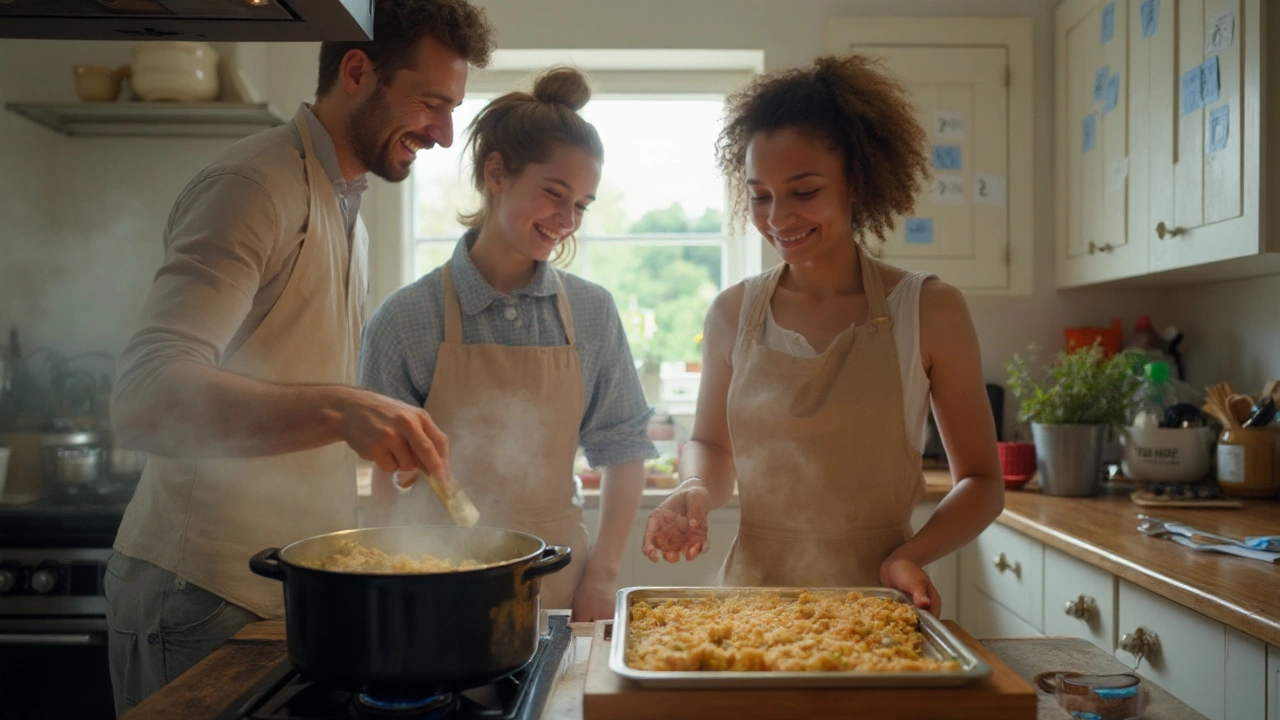
Shop smart in New Zealand: where to save and what to buy
Shop with a short list, a round number budget, and a rule: no “maybe” items. In Auckland I rotate between Pak’nSave for specials, Asian grocers for rice/spices/soy, and fresh markets for bulk produce when I can. Countdown and New World can still be fine if you ride their weekly app specials and “reduced to clear” shelves.
Where to get the best value:
- Pak’nSave: good for meat specials, canned goods, big bags of rice, frozen veg.
- Asian grocers: best unit prices on rice, lentils, spices, soy, vinegar, noodles, tofu. Whole spices here often cost less than tiny supermarket jars.
- Fresh markets and produce shops: cabbages, onions, carrots, potatoes by weight or crate deals.
- Bulk bins (Bin Inn, some Asian supermarkets): buy the exact amount of lentils, spices, oats you need.
Unit pricing wins: compare dollars per 100 g or per kg. 1 kg pasta at $2.20 beats 500 g at $1.60. Same for cheese and yogurt-buy bigger only if you’ll use it.
Big savings from swaps:
- Chicken breasts → drumsticks or bone-in thighs.
- Pre-grated cheese → block cheese, or skip cheese and add a breadcrumb-herb topping.
- Bagged slaw mix → half a cabbage + two carrots sliced thin.
- Expensive herbs → onions, garlic, and a squeeze of lemon or splash of vinegar.
- Brand spices → bulk or Asian grocer packets.
Pitfalls to avoid:
- Small spice jars: brutal per-gram pricing.
- Pre-marinated meat: you’re paying for sauce and water. Make a 30-second marinade at home.
- Recipe hopping: switching plans mid-aisle adds random costs.
Example shopping list for Menu A (One-Pot Chicken Pilaf + Slaw) - Auckland prices I’ve paid recently:
- Chicken drumsticks, 1.6 kg: $10-$12 (on special)
- Basmati rice, 700 g (from 5 kg bag): $1.60-$1.80
- Onions, 800 g: $2
- Carrots, 1 kg: $2
- Frozen peas, 500 g: $2
- Whole cabbage, 1 medium: $3
- Yogurt, 500 g plain: $3-$4
- Oil/spices (cumin, paprika, turmeric) + lemon/vinegar: ~$2-$3 share of pantry
Estimated total: $26-$29 for the bulk, then add pantry items. If you’re starting from zero spices, grab a $2-$3 packet each of cumin and paprika at an Asian store, and you’re still well under $40.
Now, let’s price all three menus with rough totals and per-person costs so you can choose what fits this week’s specials.
| Menu | Serves | Estimated Total (NZD) | Cost Per Person |
|---|---|---|---|
| Menu A - Chicken Pilaf + Slaw + Yogurt | 8 | $35-$42 | $4.40-$5.25 |
| Menu B - Lentil Bolognese + Spaghetti + Carrots + Toasted Bread | 8 | $28-$34 | $3.50-$4.25 |
| Menu C - Bean & Kumara Chili + Rice + Pickled Onions | 8 | $30-$36 | $3.75-$4.50 |
Note: If you already have oil, spices, and soy, your totals drop a few dollars. If meat specials are weak this week, lean into Menu B or C.
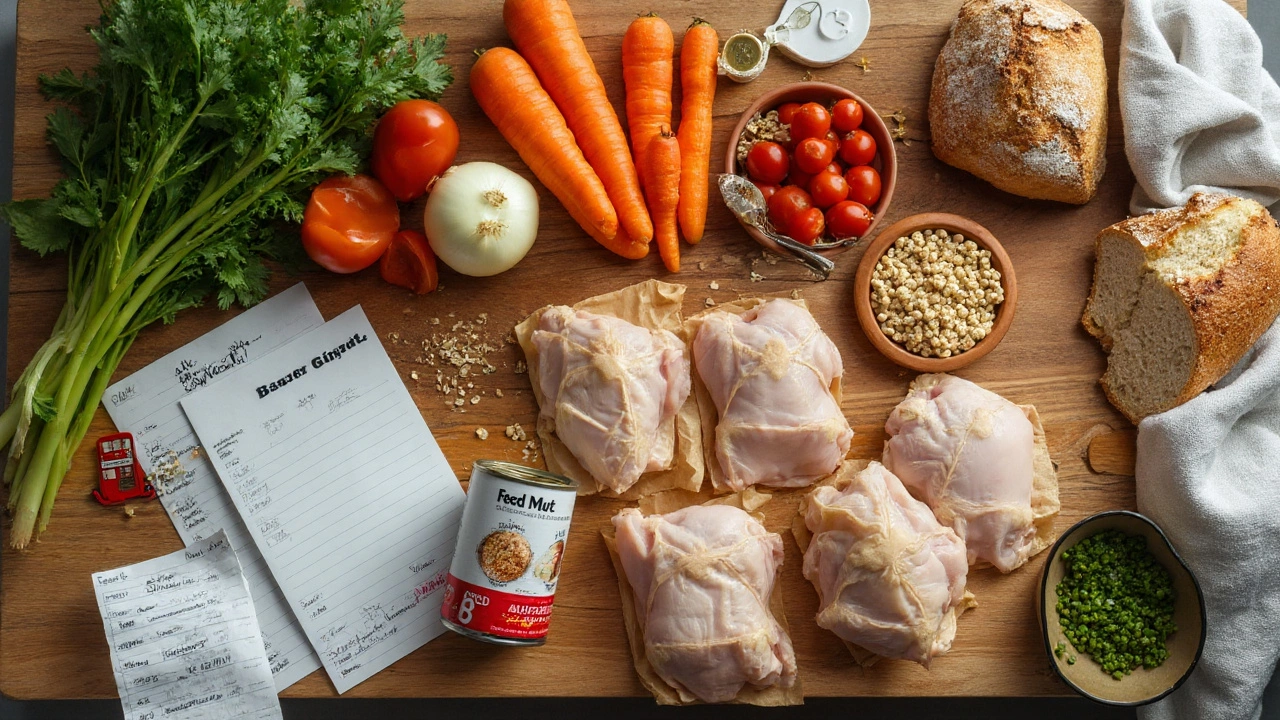
Cook big without stress: crowd-sized recipes and timelines
Here’s a simple 60-75 minute flow I use. You’ll cook hot and fast, but not frantic.
- Turn on the oven (if using) and boil your kettle. Heat buys you time.
- Start your carb first (rice/pasta/potatoes). Big pots, salted water.
- While the carb goes, chop onions/carrots/cabbage. Mix any quick sauces (yogurt, vinaigrette).
- Get protein going in one pot/pan. Season hard-salt, pepper, one bold spice, acid at the end.
- Finish the veg (steam, pan-fry, or slaw). Toss with oil, salt, acid.
- Combine and rest. Taste, adjust salt and acid, then serve family-style.
Now the three menus with quantities for eight, step-by-steps, and cheap flavour tricks.
Menu A - One-Pot Chicken Pilaf + Cabbage Slaw + Garlicky Yogurt
Serves: 8
What you need:
- Chicken drumsticks 1.6-1.8 kg
- Basmati/long-grain rice 600-700 g (about 3 cups)
- Onions 2 large, diced
- Carrots 3 large, diced
- Frozen peas 2 cups
- Oil 3-4 tbsp
- Spices: 2 tsp ground cumin, 2 tsp paprika, 1 tsp turmeric
- Salt, pepper
- Water or stock 5-5.5 cups (for 3 cups rice; adjust to rice type)
- Cabbage 1/2-3/4 head, thinly sliced
- Carrot 2, grated (for slaw)
- Plain yogurt 400-500 g + 1 clove garlic + lemon juice or vinegar
How to cook it (one pot + one bowl):
- Season chicken with 1 tsp salt, pepper, cumin, paprika. Sear in a wide heavy pot with oil, 5-6 minutes each side, until coloured. Remove to a plate.
- In the same pot, add a splash of oil if dry. Cook onions and diced carrots with 1 tsp salt until soft and golden at the edges, 6-8 minutes. Stir in turmeric.
- Rinse rice until water runs clear. Tip rice into the pot, stir to coat with oil and spices for 1-2 minutes.
- Add hot water or stock (start with 5 cups), bring to a simmer. Nestle chicken on top. Lid on. Low heat 18 minutes.
- Add peas on top, turn off heat, and rest 8-10 minutes with lid on. Check liquid; if it needs a splash more, add a little, cover 5 minutes.
- Mix slaw: cabbage + grated carrot with 2 tbsp oil, 1-2 tbsp vinegar or lemon, salt, pepper. Let it soften while pilaf rests.
- Stir yogurt with crushed garlic, a squeeze of lemon, salt, and a splash of water to loosen.
- Fluff rice, taste for salt, then serve with slaw and garlicky yogurt.
Pro tip: If you don’t have stock, add a teaspoon of soy sauce to the cooking water. It deepens the savoury without tasting “soy”.
Optional $5 dessert: Cinnamon sugar flatbreads. Mix 2 cups flour, 1 cup yogurt, pinch salt. Pan-fry small rounds in oil. Dust with cinnamon sugar.
Menu B - Lentil Bolognese + Spaghetti + Buttered Carrots + Toasted Bread
Serves: 8
What you need:
- Spaghetti 800-900 g
- Red lentils 500-600 g dried (or 4 cans brown/green lentils, drained)
- Canned tomatoes 3 cans (400 g each)
- Onions 2, finely chopped
- Carrots 3, finely chopped + 6 medium for side
- Garlic 3-4 cloves (or 1 tsp garlic powder)
- Oil 3-4 tbsp
- Spices: 1 tsp chili flakes (optional), 2 tsp dried oregano or mixed herbs
- Soy sauce 1-2 tbsp or a stock cube
- Butter 50 g (or oil) for carrots
- Bread 1 loaf (cheap white is fine), for toasting
How to cook it:
- Rinse red lentils. In a large pot, sauté onions, chopped carrots, and garlic in oil with 1.5 tsp salt until soft, 8-10 minutes.
- Add tomatoes, 2 cans of water, oregano, chili flakes. Stir in lentils. Simmer 20-25 minutes, stirring often, until lentils are tender and sauce is thick. Add soy sauce to taste.
- Boil spaghetti in salted water until just tender. Reserve a cup of pasta water. Toss pasta with a ladle of sauce so it doesn’t stick.
- Slice remaining carrots into coins. Steam or microwave until just tender, then toss with butter and salt. If no butter, use oil plus a squeeze of lemon.
- Toast bread slices under the grill or in a dry pan. Rub with a cut garlic clove if you have it.
- Serve pasta, top with ladles of lentil bolognese. Add carrots on the side and toast for crunch.
Pro tip: Stir a splash of pasta water into the sauce to make it silky. If you’ve got a small knob of cheese, grate just a dusting on top for aroma and save the rest.
Menu C - Smoky Bean & Kumara Chili + Rice + Quick Pickled Onions
Serves: 8
What you need:
- Rice 600-700 g
- Kumara (orange or red) 1.2-1.5 kg, cubed
- Canned beans 4-5 cans (kidney/black beans), drained
- Canned tomatoes 2 cans
- Onions 2 large, chopped
- Garlic 3 cloves (or 1 tsp powder)
- Oil 3 tbsp
- Spices: 1 tbsp smoked paprika, 1-2 tsp cumin, chili powder to taste
- Vinegar 4-5 tbsp (white or apple cider)
- Sugar 1 tsp (balances acidity)
- Salt, pepper
How to cook it:
- Start rice: rinse and cook as usual.
- Roast or pan-cook kumara: toss with oil, salt, paprika; roast at 200°C for 20-25 minutes, or pan-fry covered until tender and caramelised.
- In a pot, sauté onions and garlic with oil, cumin, and chili powder. Tip in tomatoes, 1 can of water, beans, 1 tsp salt, and sugar. Simmer 15-20 minutes until thick and saucy.
- Stir the roasted kumara into the chili at the end to keep shape.
- Quick pickle: slice half an onion thin, toss with 2-3 tbsp vinegar, pinch salt, pinch sugar. Rest 10 minutes.
- Serve chili over rice with pickled onions and a drizzle of oil or yogurt if you have it.
Pro tip: A teaspoon of cocoa powder or instant coffee deepens the chili if you’ve got some lying around.
Timing cheat-sheet for any of the menus (start to serve in ~70 minutes):
- 0:00-0:10 - Kettle on. Chop onions/carrots/kumara. Season protein (if using). Oven on if needed.
- 0:10-0:20 - Start rice/pasta. Sear protein or start lentil/bean base with onions.
- 0:20-0:40 - Build sauce (tomato + spices). Roast veg or simmer lentils/beans. Stir twice to prevent sticking.
- 0:40-0:55 - Make slaw, butter carrots, or pickle onions. Taste and season sauces.
- 0:55-1:10 - Combine, rest 5-10 minutes, plate up family-style.
Gear that helps (but not required): one 6-8 L stockpot, one large deep pan, one baking tray, a big bowl, and a sharp knife. That’s it.
Food safety: Cool leftovers fast (shallow containers, fridge within 1 hour). Rice can be risky if left warm too long-chill it quickly and reheat to steaming hot the next day.
Waste-free plan for tomorrow:
- Pilaf → fry into crispy rice cakes; top with a fried egg.
- Lentil bolognese → thin with water for soup; add a squeeze of lemon.
- Chili → wrap into burritos with any lettuce/cabbage; freeze tightly wrapped.
Pantry-first substitution list (so you don’t run back to the shop):
- No yogurt? Mix mayo with a splash of water and lemon.
- No cumin? Use coriander powder or a curry powder blend.
- No canned tomatoes? Use tomato paste + water + a pinch of sugar and vinegar.
- No beans? Use lentils or split peas; adjust water and time.
- No bread? Toast leftover wraps or make quick flour + water flatbreads.
Checklist you can screenshot
- Pick 1 menu. Don’t change your mind in aisle three.
- Budget: $35-$48 total for 8. Track as you add items.
- Buy: one big carb, one protein, one big veg, one sauce booster.
- Unit price beats shelf price. Bigger isn’t always cheaper-check the label.
- Cook carb first, sauce second, veg third. Serve with acid and salt at the end.
Mini‑FAQ
How much meat do I need for 8? About 1.6-1.8 kg of bone-in chicken, or 1.2-1.4 kg boneless thighs. For mince, 800 g is plenty if you bulk with lentils or beans.
Can I keep this gluten-free? Yes. Use rice or potatoes instead of pasta. Thickening sauces with a spoon of mashed beans or a splash of oil works fine.
What if I’ve got picky kids? Keep things separate: plain rice/pasta, sauce on the side, raw veg sticks, a small bowl of grated cheese or yogurt. Same meal, different assembly.
Is there a super-cheap protein swap? Eggs. A 20-pack on special plus rice and veg can feed 8 as a fried rice or shakshuka-style eggs in tomato sauce.
Do I need stock? No. Salt, soy sauce, and a bit of onion do 90% of the work. Finish with lemon or vinegar to wake flavours up.
When are markdowns best? Early mornings and after the dinner rush, I often spot “reduced to clear” tags on meat and bread. It varies by store and suburb-worth a quick look.
Next steps & quick troubleshooting
- No oven? Do Menu B or C fully on the stovetop. For Menu A, simmer chicken on the rice as written.
- Tiny kitchen? Cook in two waves: make the sauce early, reheat gently while pasta or rice cooks.
- Very tight budget this week? Run Menu B, skip bread, add 1 more carrot and 1 more onion to the sauce. You’ll still be under $30 if you’ve got oil and spices.
- Short on time? Use canned lentils/beans and pre-chopped frozen veg. Dinner in 35-40 minutes.
- Need to scale to 12? Increase carb by 50%, protein by 25-30%, veg by 30-40%. Season in layers so it doesn’t go bland.
If you stick to the framework-carb + protein + veg + sauce-you can feed a hungry crew without draining your wallet. The menus here aren’t just cheap; they’re solid, repeatable, and friendly for New Zealand kitchens and prices right now.
